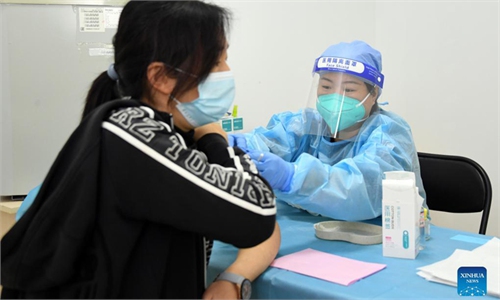COVID-19 surge affects 10 provinces, but better positioned to contain flare-up with increaisng vaccination

A medical worker takes a swab sample from a child for nucleic acid test at a residential area in Ejina Banner of Alxa League, north China's Inner Mongolia Autonomous Region, Oct. 20, 2021.Photo: Xinhua
Since two tourists originally from Shanghai were found COVID-19 positive in Northwest China's Shaanxi Province on October 16, this wave of epidemic resurgence has spilled to at least 10 provinces and municipalities as of Thursday. Virus gene sequencing of the infected patient in Beijing showed this wave points to the Delta variant, but the original transmission source remains unclear.
Epidemiologists concluded that thanks to rich experience in handling sporadic outbreaks, and as the vaccination rate soars, China is in a better position to contain sporadic outbreaks. Yet, they also urged the public to remain alert as winter approaches and the original source of infection remains to be found.
Six days have passed but transmission links related to this resurgence continue to expand. On Wednesday, 13 confirmed cases and seven asymptomatic cases were found, affecting Gansu, Ningxia, Inner Mongolia, Hubei, Hunan, Hebei, Guizhou, and Yunnan around the country, the National Health Commission reported.
On Thursday, Beijing reported one case and Baoding, a city in North China's Hebei Province, reported two who had been to scenic spots in Inner Mongolia and Gansu's Zhangye. Southwest China's Guizhou Province also reported three coronavirus-positive cases the same day.
Pang Xinghuo, deputy head of Beijing CDC, said at a press conference on Thursday that virus gene sequencing showed that the case in Beijing was the Delta variant, and belonged to the same transmission link of cases reported in Northwest China's Gansu and Shaanxi provinces.
The spread started from a tour group transmission chain in Shanghai, and the situation has become increasingly complex due to more tour group transmission chains.
Amidst rising infections related to Gansu Province, which reported six new cases on Thursday, and also the worst-hit region during this outbreak, authorities there required a negative nucleic acid report within 24 hours before people leave through the capital Lanzhou's airport, and suspended all elementary and secondary schools in Lanzhou.
The number of canceled flights to and from Northwest China's Gansu and Shaanxi provinces reached 56 percent and 58 percent, respectively, while that in Inner Mongolia reached 41 percent on Thursday, according to travel app Umetrip.
Provinces and cities across China are stepping up efforts to screen potential COVID-19 infections.
Ningxia is requiring those who had traveled to Lanzhou since October 5 and Ejina Banner since October 1 to report to local authorities for tests. Shaanxi Province also released similar notices. Hubei Province has brought forward the possibility of close contacts to the end of September.
Judging from the notices, experts said close contacts of the current outbreak may have occurred since October 1. Official data showed from October 1 to 7, China's National Day holiday, 515 million domestic trips were made.
A public health expert based in Beijing surnamed Wang told the Global Times that the possibility of this flare-up starting from the National Day holidays could not be ruled out.
To cut off transmissions related to tourism, Hangzhou in East China's Zhejiang called off travel to nine places in Shaanxi, Ningxia, Gansu and Inner Mongolia.
Wang said despite the National Day holidays, it is unlikely to develop into a nationwide outbreak because emerging cases have shown clear transmission routes, most of which were closely related to provinces in North and Northwest China.
Shao Yiming, a leading physician and immunologist at the Chinese Center for Disease Control and Prevention (China CDC), told Chinese media that sporadic outbreaks are common, especially after the National Day holidays. China was able to curb the epidemic resurgence after last year's National Day holidays even without a massive vaccination rate. More than 80 percent of people in China are now fully vaccinated.
China's epidemic prevention and control strategy in the past had proven effective, and now that vaccinations have built an immune barrier, China is in a better position to contain sporadic outbreaks, Shao said.
As the original transmission sources have yet to be found, more cases are likely to be reported. The scale of this wave may be equivalent to the one in Nanjing, Wang noted.
Shao suggested people who meet the criteria should get booster shots as soon as possible due to the waning level of antibodies as time passes. Giving booster shots to people fully vaccinated for six months has been carried out in at least 20 provinces and municipalities, including Beijing.

A medical worker takes a swab sample from a child for nucleic acid test at a residential area in Ejina Banner of Alxa League, north China's Inner Mongolia Autonomous Region, Oct. 20, 2021.Photo: Xinhua
Since two tourists originally from Shanghai were found COVID-19 positive in Northwest China's Shaanxi Province on October 16, this wave of epidemic resurgence has spilled to at least 10 provinces and municipalities as of Thursday. Virus gene sequencing of the infected patient in Beijing showed this wave points to the Delta variant, but the original transmission source remains unclear.
Epidemiologists concluded that thanks to rich experience in handling sporadic outbreaks, and as the vaccination rate soars, China is in a better position to contain sporadic outbreaks. Yet, they also urged the public to remain alert as winter approaches and the original source of infection remains to be found.
Six days have passed but transmission links related to this resurgence continue to expand. On Wednesday, 13 confirmed cases and seven asymptomatic cases were found, affecting Gansu, Ningxia, Inner Mongolia, Hubei, Hunan, Hebei, Guizhou, and Yunnan around the country, the National Health Commission reported.
On Thursday, Beijing reported one case and Baoding, a city in North China's Hebei Province, reported two who had been to scenic spots in Inner Mongolia and Gansu's Zhangye. Southwest China's Guizhou Province also reported three coronavirus-positive cases the same day.
Pang Xinghuo, deputy head of Beijing CDC, said at a press conference on Thursday that virus gene sequencing showed that the case in Beijing was the Delta variant, and belonged to the same transmission link of cases reported in Northwest China's Gansu and Shaanxi provinces.
The spread started from a tour group transmission chain in Shanghai, and the situation has become increasingly complex due to more tour group transmission chains.
Amidst rising infections related to Gansu Province, which reported six new cases on Thursday, and also the worst-hit region during this outbreak, authorities there required a negative nucleic acid report within 24 hours before people leave through the capital Lanzhou's airport, and suspended all elementary and secondary schools in Lanzhou.
The number of canceled flights to and from Northwest China's Gansu and Shaanxi provinces reached 56 percent and 58 percent, respectively, while that in Inner Mongolia reached 41 percent on Thursday, according to travel app Umetrip.
Provinces and cities across China are stepping up efforts to screen potential COVID-19 infections.
Ningxia is requiring those who had traveled to Lanzhou since October 5 and Ejina Banner since October 1 to report to local authorities for tests. Shaanxi Province also released similar notices. Hubei Province has brought forward the possibility of close contacts to the end of September.
Judging from the notices, experts said close contacts of the current outbreak may have occurred since October 1. Official data showed from October 1 to 7, China's National Day holiday, 515 million domestic trips were made.
A public health expert based in Beijing surnamed Wang told the Global Times that the possibility of this flare-up starting from the National Day holidays could not be ruled out.
To cut off transmissions related to tourism, Hangzhou in East China's Zhejiang called off travel to nine places in Shaanxi, Ningxia, Gansu and Inner Mongolia.
Wang said despite the National Day holidays, it is unlikely to develop into a nationwide outbreak because emerging cases have shown clear transmission routes, most of which were closely related to provinces in North and Northwest China.
Shao Yiming, a leading physician and immunologist at the Chinese Center for Disease Control and Prevention (China CDC), told Chinese media that sporadic outbreaks are common, especially after the National Day holidays. China was able to curb the epidemic resurgence after last year's National Day holidays even without a massive vaccination rate. More than 80 percent of people in China are now fully vaccinated.
China's epidemic prevention and control strategy in the past had proven effective, and now that vaccinations have built an immune barrier, China is in a better position to contain sporadic outbreaks, Shao said.
As the original transmission sources have yet to be found, more cases are likely to be reported. The scale of this wave may be equivalent to the one in Nanjing, Wang noted.
Shao suggested people who meet the criteria should get booster shots as soon as possible due to the waning level of antibodies as time passes. Giving booster shots to people fully vaccinated for six months has been carried out in at least 20 provinces and municipalities, including Beijing.



